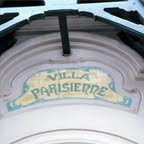Last week we went to see Lindsay Lowend play at "La Bellevilloise". This venue, in the heart of Paris' 20th arrondissement, is three blocks away from where we used to live on the rue de l'Est so I know the neighborhood well.
 |
|
"Un rond, c'est un carré qui a mal tourné", rue de l'Est © Perry Tak - 08/2007 Les rues de Paris |
We found a parking spot on the rue des Pyénées, right next to the Place du Guignier. A guignier is a kind of cherry tree although the only cherries I've ever seen in this place are in the stalls on market day.
 |
| place du Guignier - "Ceci n'est pas un Magritte" © Jacques Deneux - 04/2009 Les rues de Paris |
La Place du Guignier may seem calm and picturesque but for me it will always be:
The place of the electrocuted dog
after an incident that took place on Sunday, 27 January 2013. One of our neighbors, a middle-aged woman, owned a small, black, yappy dog. The dog would stand at the sliding glass windows on the second floor and bark incessantly at passersby, in particular at those accompanied by dogs which happened to be our case. That evening the neighboor took her dog for a walk in the square around the corner from the apartment. The weather had been damp, through a kind of "capillarity", some stripped wires electrified the metal manhole cover. When the small, black dog (yes, I know the photo accompanying the article shows a white dog but it is a stock photo, the dog was black), anyhow, when the tiny dog walked across the electrified manhole cover he received a discharge of about 180 volts. The woman tried to rescue her dog and she also received an electrical shock but she was not killed. It was, indeed, a rather tragic occurrence and one that certainly marked my memory. This story, however, did not impress the person accompanying me.

As usual, Lindsay Lowend's show was great...


As usual, Lindsay Lowend's show was great...

and I even got my picture with him!













